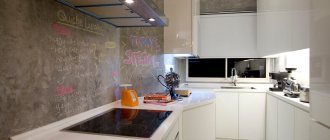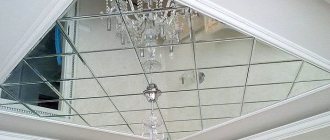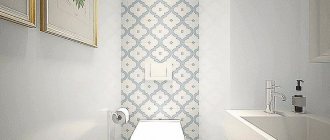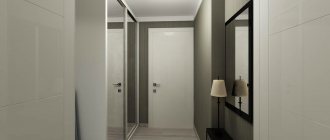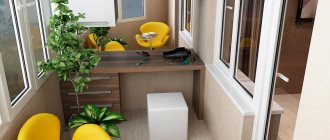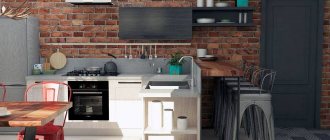Which tiles are suitable for the floor in the kitchen, how to choose the right size, format and read the labeling, the nuances of laying tiles on the floor, manufacturers, prices and photos of floor tiles in the kitchen interior - here.
Ceramic floor tiles have many advantages. The main one is that tiles will last in the kitchen much longer than laminate or linoleum, and are much more practical to clean. But it also has plenty of disadvantages.
Ceramics is a very cold material. You can only walk on tiles in indoor shoes. Therefore, if you want to make your kitchen more comfortable, you will have to invest in a heated floor system. Due to its excellent thermal conductivity, ceramic tiles are ideal for its construction. Unlike the same linoleum.
Another disadvantage of tiles is poor sound insulation, so a soundproofing layer may be needed. An active child can injure their knees on hard tiles, and cups or plates that accidentally fall on the floor are guaranteed to break. And the tile itself can crack from a strong blow. Laying tiles requires time, experience or money, and the work is quite messy.
Don't these disadvantages scare you? Then let’s figure out how to choose the best tiles for your kitchen.
Which tile to choose for the kitchen floor
- You can’t put wall tiles on the floor (its surface will quickly lose its beautiful appearance, and the tiles themselves may crack), but you can put floor tiles on walls. Floor tiles are much stronger and more durable thanks to special production technology. Look for the foot marking on the box. Wall tiles are indicated by an icon in the shape of a palm.
- For the kitchen, it is especially important that the floor surface is not slippery. High-quality ceramic tiles must be marked with a coefficient of friction. If it is more than 0.75, such tiles are non-slippery and quite safe; they can be safely placed in the kitchen. Do not choose tiles with a friction coefficient of less than 0.4 - if water spills on the floor, someone in your household may slip.
- The floor in the kitchen is subject to the heaviest loads, so experts recommend laying durable and wear-resistant tiles - hardness class III according to the PEI classification or class 5 according to GOST. If you don't use your kitchen very often, PEI II class is also suitable, but such tiles are less durable. Some manufacturers designate wear-resistant tiles with a shaded foot icon.
- If you like your kitchen to be sparkling clean and often wash your floors with strong detergents, you should give preference to ceramic tiles labeled AA. The surface of such ceramics has maximum resistance to chemicals. This means that she is not afraid of the most aggressive household chemicals. The protective layer of such tiles repels dirt and is easy to clean.
- For a kitchen floor, matte rather than glossy tiles are better suited. Scratches and abrasions are much less noticeable on matte and semi-matte surfaces. However, keep in mind that if the tiles are too rough and porous, all the dirt will stick to them and the floor will always look dirty. For the same reason, you should not place tiles that are too textured in the kitchen.
Requirements for kitchen floor surfaces
Kitchen floor tiles must meet a number of requirements:
- strength and wear resistance;
- moisture resistance;
- fire safety;
- resistance to temperature changes during operation;
- neutrality to the effects of detergents containing aggressive substances;
- environmental safety - no toxic components should be released when heated.
Modern floor tiles have a long service life without losing their original appearance. Only improper installation can ruin the coating. Based on the requirements, we can conclude which tile is better for the kitchen floor - it should be class 3 and higher.
Sizes and formats of kitchen floor tiles
Square and rectangle are the most popular floor tile formats. Less common are ceramic or cement tiles in hexagonal or octagonal shapes. As a rule, it is used in classic or traditional kitchen interiors.
As for sizes, most often tiles of 20x20, 30x30, 40x40 cm and their variations are laid on the floor. For example, 31.6x31.6 or 33.3x33.3 cm. Sometimes on the kitchen floor you can also find small tiles in the format 10x10 or 15x15 cm. They look best in a kitchen in Provence or country style, but sometimes they fit perfectly into a modern interior . Floor tiles are thicker and stronger than wall tiles. Its average thickness is from 6.5 to 11 mm.
Catalog of kitchen furniture manufacturers
Russian, Belarusian, Italian, German, Czech and Scandinavian factories: description of the range and photos of popular models... View
Photo ideas
Note! Glass kitchen apron - how to choose? 70 photos of the perfect combination in the kitchen!
Let's discuss this article together:
Click to cancel reply.
Color and tone
Ceramic tiles from the same collection, but from different batches, differ not only in size, but also in tone. For example, the color can be darker or lighter, brighter or, conversely, muted. Manufacturers sort the tiles by tone and put the appropriate markings on the box. As a rule, this is a combination of letters and numbers or some kind of symbol.
For example, A45 or 12.
Before you pay for your purchase, make sure that all the tiles you have chosen are from the same batch and the markings on the boxes completely match in all respects.
Designer's advice If a tile of one tone is not enough for you, take a tone that is as close as possible to the chosen one. For example, if you need a B12 tone, B11 or B13 will do. If there are none, take any tile marked with tone B. But be sure to take the tiles out of the boxes and make sure that the differences in tone are not critical. If the tones of the tiles differ too much, you can use a trick. A significant part of the floor in the kitchen is occupied by the kitchen unit, and no one will see the floor underneath it. The main thing is to lay out the tiles when laying them so that the central, visible part of the floor is as uniform in color as possible.
Types of flooring
Tiles are divided into types for several reasons: production method, surface type. For the kitchen, pressed and glazed are suitable, but with a rough surface, respectively. There is another basis for sorting - the material that was used in production.
Tile
When listing the types of floor tiles, ceramics are mentioned more often. It is durable and does not crack when a heavy object (frying pan, pot) falls. Other benefits include:
- best quality/price ratio;
- resistance to aggressive detergents, making it easier to remove dirt;
- service life - about 15 years;
- moisture and fire resistance;
- resistance to direct sunlight - even brightly colored kitchen floor tiles will retain the color intensity;
- easy dismantling in case of damage to an individual segment;
- health safety.
The tiled floor even fits into kitchens up to 6 m². By changing the direction of the ornament, it is possible to visually change the shape of the room. Using tiles of different colors, you can create “carpets”.
Kitchen tiles have the following disadvantages:
- low level of sound insulation;
- complexity of installation;
- surface is slippery.
Important! When laying tiles on the floor, you must remember that this material is tactilely cold. Therefore, if children live in the house, it is recommended to organize a “warm home” system.
Porcelain tiles
With the advent of new materials, tiles for the kitchen floor are not considered as the only type of flooring. An alternative is kerogranite. It has an artificial nature, the surface imitates natural stone.
Porcelain tiles are chosen for kitchen flooring because of the following advantages:
- resistance to abrasion of the pattern due to a special dyeing technology;
- strength, but subject to proper installation.
But ceramic tiles for the kitchen also have disadvantages. Firstly, the high price. Secondly, the conditions of transportation and laying are very difficult. And thirdly, fragility.
Vinyl tiles
An example of a modern floor covering. The material is abrasion resistant, which suits the kitchen conditions. Tactile tiles are very warm, so the floor does not require additional insulation or a heating system.
If the tiles are fixed with glue, then when installing vinyl tiles, the choice of fixation methods is wider - a locking system, a self-adhesive layer, an adhesive chamfer. This makes installation even easier.
There are several classes based on the degree of wear resistance. It is recommended to lay semi-commercial and commercial tiles on the kitchen floor. This is 32-42 class. Its service life is from 12 to 15 years.
Choosing a floor tile design for the kitchen
- A light tile floor will make your kitchen brighter and visually more spacious, so this option is well suited for a small space. Dark tiles will only emphasize the small size of the kitchen. But even if the space allows, you should definitely compensate for the dark floor with light furniture and wallpaper.
- If your kitchen windows face north or west, choose a solid finish in warm, light colors for the floor. And a warm “southern” kitchen will also respond well to tiles of rich, cold shades.
- In a kitchen in a modern, high-tech or minimalist style, the best choice is a plain floor or tiles with the most neutral and unobtrusive pattern. A classic-style kitchen will be perfectly complemented by marble-effect tiles or ceramics with antique ornaments. A country or Provence interior will be completed by a floor laid with artificially aged ceramics, imitation cotto tiles, or a patterned ceramic “carpet” made of Metlakh tiles or its imitation.
Among the floor tiles, there are many collections in natural colors - different shades of brown, beige, gray. These flowers have an important advantage - they do not stain and are therefore well suited for the kitchen.
Wood-effect floor tiles or ceramic parquet
You can read in great detail about this finishing material in this special review. Keep in mind: most wood-look tiles are not tiles, but porcelain tiles. Long ceramic tiles, reminiscent of boards or laminate, break easily, so short “planks” or square tiles with a wood pattern, imitating type-setting parquet, are often made from tiles.
Wood-look tiles are often rectified and laid without visible seams. This creates a very authentic illusion of a real wood floor, parquet floor or solid wood surface.
The simplest and most unpretentious wood-effect floor tiles can be bought in online stores in Moscow and the region for about 470-700 rubles per square meter (for example, the Dublin collection from Uralkeramika, Karelia from the Kharkov Tile Factory). Russian wood-effect tiles and parquet from the Kerama Marazzi factory cost approximately 650 rubles per square meter (Wonderful Garden, Cassia, Glasgow collections).
Prices for Spanish ceramics that imitate a wooden floor start from 1300-1500 rubles per square (Wood collections from Monopole Ceramica, Brilliant from Absolut Ceramica, Lignum Natural and Savage from the Cifre factory, Bosco from Gaya Fores, etc.)
Stone effect floor tiles
In many cases, a good ceramic imitation can only be distinguished from natural stone by its appearance only by professionals. Modern production technologies make it possible to convey the characteristic pattern and texture of granite, quartzite, marble, basalt or other rock. In most cases, stone-look tiles are also not tiles, but porcelain tiles - they are stronger and more durable than ordinary ceramics. But even among ordinary ceramic tiles you can find very interesting solutions.
For inexpensive options (on average 500-700 rubles per square meter in Moscow online stores), pay attention to the collections of the Volgograd Ceramic Factory (Allegro), Kerama Marazzi (Transbaikalia, Cameo, Still Life, Aurelia, Sella, etc.), Shakhtinskaya tiles ( Pietra), Atem, Jade Ceramics (Watercolor), Uralceramics (Adagio).
The average price option is Polish “stone” tiles for 1000-1200 rubles per square meter (Samaria from Tubadzin, etc.) and Spanish ceramics for 1000-2700 rubles per square meter (collections from factories Europa Ceramica, MYR Ceramica, Venus Ceramica, Mainzu, Argenta Ceramica, Pamesa, Keros Ceramica, Dualgres, etc.).
Italian stone-look floor tiles vary greatly in price - depending on the factory, their cost varies from 1200 to 4000 rubles per square meter (factories Imola Ceramica, Serenissima Sir La Faenza, Del Conca, Majorca, etc.
Important! Not original, but very important advice - be sure to buy tiles with a reserve. Some of the tiles may break during installation, get “lost” when trimmed, or your floor will require repairs over time, and you will no longer be able to find tiles exactly the same in tone and size. If the styling pattern is simple, 5% is enough. For complex modular or diagonal installations, it is better to add at least 10% on top.
Laying tiles on the floor - 3 things you need to know
- If you are planning to do kitchen renovations yourself or save on the services of a tiler by inviting a cheaper specialist, keep in mind: the slightest deviation from tile laying technology can have dire consequences. If the subfloor is not level enough and there is an air gap between the floor and the tiles, the tiles can easily crack if something heavy falls on them and will have to be replaced. Make sure that such voids are no more than 10% of the floor area and that they are not concentrated in one place.
- It is highly advisable to remove the old flooring. A tiled floor will last a long time only if the base is well prepared. It should be smooth, hard and dry. If the floor is cement, remove any bumps and uneven spots and seal cracks and holes. If it is old wooden, properly fix the “loose” boards and strengthen them with additional spacers.
- Thoroughly clean the floor of dust and debris. All this is necessary so that the tiles and glue can adhere to the surface as best as possible.
Floor tiles in the kitchen are well complemented by ceramic baseboards. Many European ceramics manufacturers complete their collections with them. Of course, plastic skirting boards are much cheaper, but ceramic ones - plain or with decorative patterns - look much more beautiful and impressive. Especially if you have an expensive set, and the style of your kitchen is classic, country or Provence. The length of such a plinth is usually the same as that of floor tiles. It is sold individually, like any ceramic decor. There are usually 6 or 12 pieces in a box. Sometimes thrifty owners make ceramic baseboards themselves - they simply cut the floor tiles into strips of the required height. The main disadvantage of this method is that the edge of the strips turns out sharp and uneven, while the factory-made plinth has an even rounded cut - a chamfer.
Choice of shape and size
Before choosing the shape and size of floor tiles, you should calculate the area of the surface to be laid. It is advisable to draw a schematic diagram of the future tile to understand how it will lay and how much it will be needed.
The shape of floor tiles is rich in variety. The following types are available on the market:
- Traditional square. The size of the square can vary from small to gigantic.
- Rectangular in various sizes.
- Triangular.
- Multifaceted. The most interesting and varied in their execution. Laying tiles like this on the floor will look great if used in a variety of colors.
Which grout to choose for the kitchen floor
- If you have chosen plain tiles for your kitchen, you can also buy grout to match. But in many cases, contrasting seams will look better - they will highlight the geometric pattern of the floor.
- If the floor is tiled in two or more colors, designers usually use grout to match the main shade, which occupies a larger area.
- Epoxy grout is very suitable for tile joints on the floor. It is much stronger than cement, is not afraid of moisture, does not absorb dirt, and fungi do not grow on it. But it costs more and is more difficult to work with. The surface of cement grout can be treated with special protective compounds and sealants. Read more about them in our special review.

